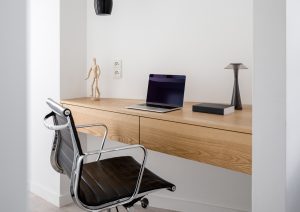Post Contents
Six tips for beating distractions and procrastination!
My working career spans 50 years. For at least 30 of those, I’ve worked from a home office. For the last 20 years, I’ve lead a team of focused writers, social media specialists and coders… all from my home office. And they all work from home too!
It works for me, it works for them and it can work for you and your employer!
Today’s technology literally allows many of us to work from anywhere we choose… on top of a mountain, on a boat in the Bahamas or in the comfort of our own home.
The Naysayer argument against working from home…
The great argument against embarking on the ‘working from home‘ journey is that you’ll be constantly distracted and unfocused. That’s the declared and undeclared position of tens of thousands of employers.
But COVID-19 is going to force many of those employers and millions of employees to put the process to the litmus test. I’m betting that this will be the real start of the ‘working from home‘ revolution.
The benefits of working from home should be obvious…
No daily commute!
And it’s not just the time saving. Sure, the hour or two (or longer) saved are extremely valuable. They can never be replaced. But there is also the mental stress of negotiating congested roads or crowded subways / buses / trams!

If you’ve been gnashing your teeth just trying to get to work, what state are you in to actually be productive? You can be brain dead by 9:00am. No wonder so many head for that coffee machine as soon as they walk through the door!
It’s cheaper for you!
It costs nothing to walk from the kitchen to your work area! Conversely, it costs most of us anything between $50 to $200 per week to get from home to an external workplace.
It’s cheaper for your employer!
Do I need to enumerate the savings in floor space, energy, security and all the other overheads that come with office space?
It’s great for the family!
Working from home has allowed me to spend quality time with my kids, time that would otherwise be squandered in traffic.
I’ve only got one still at home but I get great joy every day from opening the gate for him, telling him that I love him and ‘to have a great day’ as he rides off to school!
I’m here in the afternoon when he gets home and wants to tell me about his day. It’s 15 to 30 minutes of pure pleasure. And I don’t have to worry that I ‘should be working’ because I don’t have a 9 to 5 existence.
In fact, I usually start by 6:00am, work for 75 minutes, wake my son, spend 30 minutes or so with him, return to the ‘office’ until he’s ready to leave, play doorman and then return to work again. Try doing that from a corner office on the 32nd floor!

But what about communication with clients and fellow workers when working from home?
Seriously, it’s so easy! Easy unless you’re stuck in a time warp with emails and phone calls! So here’s tip number one… get a great collaboration tool!
That’s singular. Tool. Not tools. Get something that is totally integrated, not a suite that is patched together.
We use SamePage. I’ve used many others over the years but this is, by far, my favourite. SamePage literally puts you in a virtual office with all of your co-workers!
You can chat – keyboard or voice. You can screen share and video conference. You can retrieve documents and work on them together in real time. You can set and/or receive projects and tasks. You can ‘meet’ with contractors and clients.
In fact, with a single application, you can do everything any office does except shake hands, bump fists or high five… and isn’t that where we started?
Another collaboration tool that is also very good is Podio. We used it for three or four years until we discovered SamePage.
There are many competitors to both these products. Basecamp, Trello, Confluence and Asana all have big followings but, in my opinion, lack critical functionality.
The bottom line here is the bottom line. You will not be productive or focused if you don’t have the right collaboration and communication tools.
Set up a clear work schedule
The home environment lacks the structure of a work environment where there are timed breaks and clear start and finish times. Creating a schedule tailored to the work you want to get done can add that missing structure, reducing the procrastination that tends to take place otherwise.
So make a plan for your work that has clear and realistic goals that you can expect to achieve within a given time frame.
If your goal is to write a ten-page report, break that task down into smaller and more manageable steps that are less overwhelming. For example, you may want to start with doing background research before writing and then prepare an outline, setting a goal to write a specific number of pages a day.
Organising your larger task into several smaller ones also provides opportunities to experience small successes, which can accumulate and help keep you motivated and productive.
Whichever way you organise your work-at-home schedule, try to include reasonable breaks. Plan in time for meals as well as short breaks to refresh your mind.
But be careful: short breaks checking personal email or social media can turn into full-on procrastinating in the form of cyberloafing or cyberslacking if you don’t limit your break time. A Pomodoro style app can help here.
Tackle task uncertainty
If you find yourself struggling to start or finish a work task, it may be because you’re unsure about what needs to be done to complete your work.
When you are working at home, it can be harder to get quick answers to reduce this uncertainty. People tend to procrastinate on tasks that are unclear or confusing and when they are not sure about what they are supposed to do.
This is because such tasks can create feelings of uncertainty that are unpleasant, and that arouse feelings of self-doubt and self-criticism. Procrastination is more likely to occur when people experience unpleasant feelings related to a task that they can’t tolerate or manage.
Before you start a new or unfamiliar work task, check to make sure you have clear guidance about what needs to be done. Because we don’t always know what we don’t know, it may take starting the task before you realise that you’re missing important information or are unclear about what’s needed to get the work done.
Becoming more aware of when you experience feelings of uncertainty is the first step towards harnessing this unpleasant feeling and taking action to get the information you need.
Having a list of key people you can contact for quick support can also help in case you find yourself being paralysed by uncertainty.
This is where a great collaboration tool like SamePage can really make a huge difference.
Reduce distractions
Working at home means having to deal with potential distractions that can take you off task. Setting yourself up to work in a quiet space that is likely to have little or no traffic from family members or flatmates is a good first step.
But remote working can also involve being online and having access to a number of digital temptations.
Some people are good at turning a blind eye to these distractions and can stay focused on their work, no matter where they are. But if you have work to do that is boring, stressful or causes you self-doubt then watching funny cat videos can become an escape to help you feel better at the expense of getting your work done.
Controlling how and when you are allowed to go online for non-work purposes can help minimise exposure to distractions from your digital environment and the risk that you will procrastinate.
Plan for interruptions
Even the best laid plans to set aside time to get your work done can fall apart when unexpected interruptions appear. If you’re not prepared, that call from your mum who just wants to chat can tempt you to procrastinate and throw your work schedule off track.
One approach that has been shown to be effective for closing the gap between intentions and actions – reducing procrastination and helping you stay productive – is to make specific if-then plans for dealing with interruptions.

This involves first thinking about the possible interruptions you might encounter, and then rehearsing how you will respond.
For example, when mum calls you might prepare to say: “Sorry, I’d love to chat but I’m actually working right now. Can I call you back after work?”
See the meaning of work
My research suggests a lack of positive feelings about a task can also contribute to procrastination. When you work at home you are surrounded by things that are personally meaningful to you. In comparison, your work can seem less meaningful.
This contrast may make it difficult at times to stay focused and productive.
Reminding yourself why your work is important and valuable to you can help rebalance the scale to increase positive feelings towards your work and reduce procrastination while working from home.
Wrapping it up…
It’s totally unnatural to get up, get dressed, grab a slice of toast, kiss the kids goodbye, hug your partner (or should that be hug the kids and kiss your partner?) and head out to fight the traffic before then sitting in an office or a cubicle for 8 hours dreading the journey home!
Our home is our castle. It can – and should – also be our office. All you need is the right tools and the right attitude to make it work.
Convinced?
Parts of this article were sourced from The Conversation…






